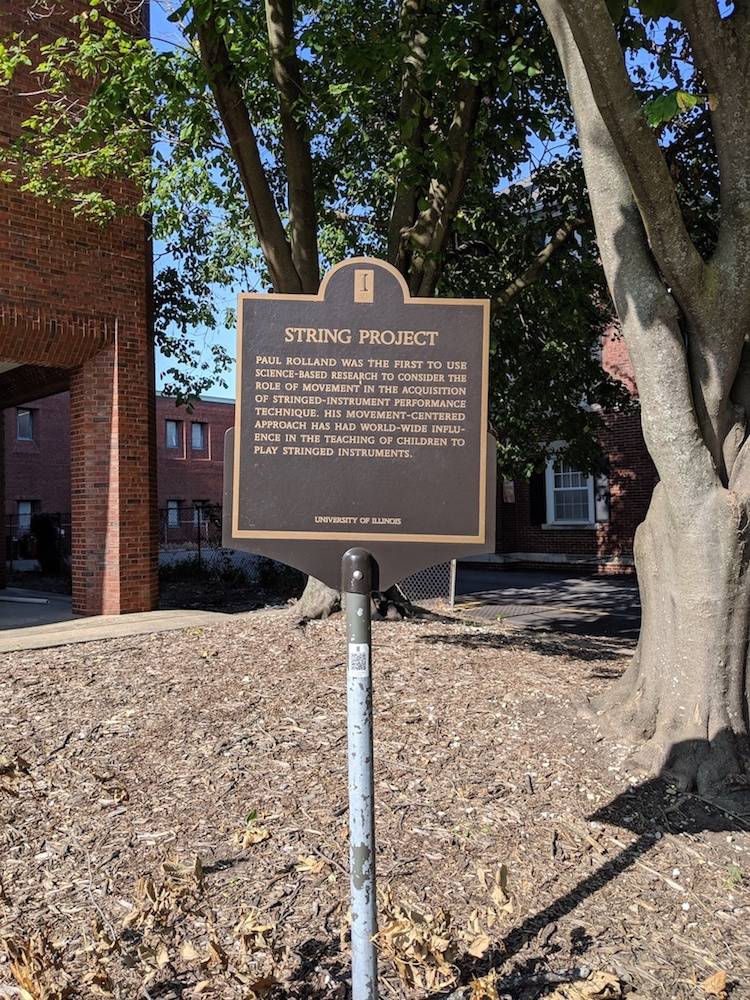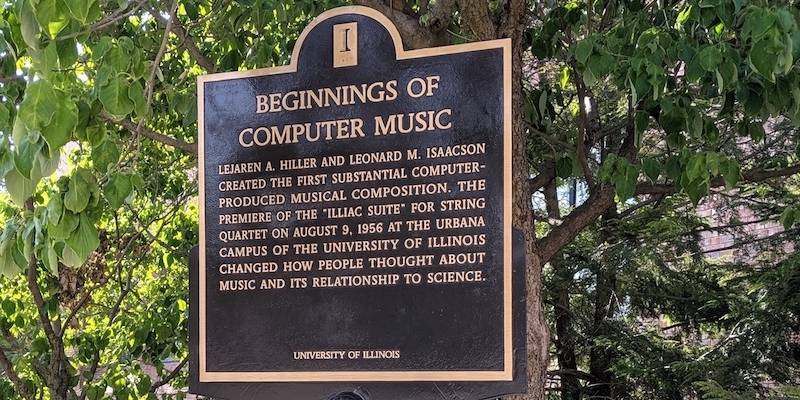With the popularity of Pokémon Go and the recent arrival of Harry Potter: Wizards Unite, location-based games have captured the imaginations of a variety of casual gamers. These games superimpose a fantasy-gaming landscape over everyday neighborhoods, anchored to locations of all types, from local businesses to historical landmarks. Unlike the vast majority of game apps, which are relatively passive, these games reward the player for getting out of the house and indulging in some exercise. Location-based games are also a great way to learn about your neighborhood, or even about other neighborhoods when you’re away from home.
There is no lack of stops for these games in the Champaign-Urbana area, many of them highlighting moments in the cities’ histories or showcasing local artists. This series will explore some of these, with an emphasis on landmarks used in Pokémon Go and Ingress.
The Beginnings of Computer Music plaque is located just outside the music building on Oregon Street. It commemorates a landmark performance that occurred at the U of I in 1956, namely the premiere of the Illiac Suite.
The Illiac Suite was the first piece of music composed with computer assistance. The computer in this case was the ILLIAC Computer (Illinois Automatic Computer), which was in turn the first computer ever built and owned by an educational institution in the U.S. The ILLIAC contained 2,800 vacuum tubes and weighed two tons, a far cry from the comparatively high-powered computers we all now carry in our pockets.
Lejaren Hiller and Leonard Isaacson, mentioned on the plaque, used four separate experiments to compose four suites with ILLIAC. The first used a predetermined melody; the second made use of four sets of rules to generate the music; the third was based on principles of dynamics and rhythm, which specific playing instructions provided; and the fourth used mathematical processes based on probability. A chemist and mathematician, Isaacson provided the more scientific side of the collaboration, although Hiller himself was also a chemist. Their collaboration resulted in the beginnings of computer-generated music.
What were the results like? You can take a listen to the full suite below, performed by the Navarra Symphony Orchestra in Madrid.
The very first performance was presented on August 9, 1956. Funded by the U of I, the performance featured students from the university’s music department. According to the Daily Illini, reviewers weren’t entirely convinced of the piece’s artistic merit, but the implications for the capabilities of computers to aid in music composition were undeniable.
In 1958, Hiller founded the U of I’s Experimental Music Studios. It started out in a single attic room but is now a state-of-the-art electro-acoustic musical facility that has produced numerous award-winning graduates, performances, and compositions. Also during his tenure at the U of I, Hiller created the MUSICOMP programming language, used for computer-generated composition.
Just behind the Computer Music plaque, you’ll find a stop in the form of the music building itself, which houses Hiller’s Experimental Music Studios as well as CAMIL (Computer-Assisted Music Instruction Laboratory). Also in the Music Building, aside from classrooms and practice areas, there are several libraries and archives, including the Musicological Archives for Renaissance Manuscript Studies, the Archive of Ethnomusicology, and the Hymn Tune index.

Walk through the building to the Nevada Street exit and you’ll find another plaque. This one commemorates Paul Rolland, whose innovative approach to music education led to new techniques for teaching the violin to young students.
Born Paul Reisman in Budapest, Hungary, Rolland came to the U.S. in 1938. By 1945, he was chairman of the faculty of the U of I School of Music. He believed that physical movement was the most important element of how a person plays the violin. Toward this end, he used scientific techniques to make detailed observations of every individual motion involved in virtuoso playing. From these meticulous studies, he developed games for young students to play in order to learn these movements. His research was documented in detail in the Illinois String Research Project films, currently held in the Sousa Archives and Center for American Music at the U of I.
Rolland also worked with the world-renowned Japanese violin teacher Shinichi Suzuki, whose class-based approach Rolland promoted in the U.S. and incorporated into his own teaching methods. Rolland’s research and the teaching methods he developed remain widely in use today, and the U of I still holds the Paul Rolland String Pedagogy Workshop every year, where students can learn his techniques, which have now been expanded to teach other stringed instruments and even conducting.
So, next time you’re Pokémon-hunting or spellcasting along Oregon or Nevada St. on campus, take a minute to stop and take a look at the plaque in front of the Music Building and queue up the Illiac Suite on your phone for a quick listen to Champaign-Urbana history. Then head over to Nevada to check out the String Project plaque, sit in the shade, and listen to some violin music while you collect more Pokéballs and plan your next raid.
For further reading:
- ILLIAC Suite
- EMS History
- Paul Rolland Workshop
- https://web.archive.org/web/20061020092022/
- http://www.astaweb.com/resources/WOPR.pdf
- Paul Rolland and the University of Illinois Strings Research Project
Photos by Katriena Knights








